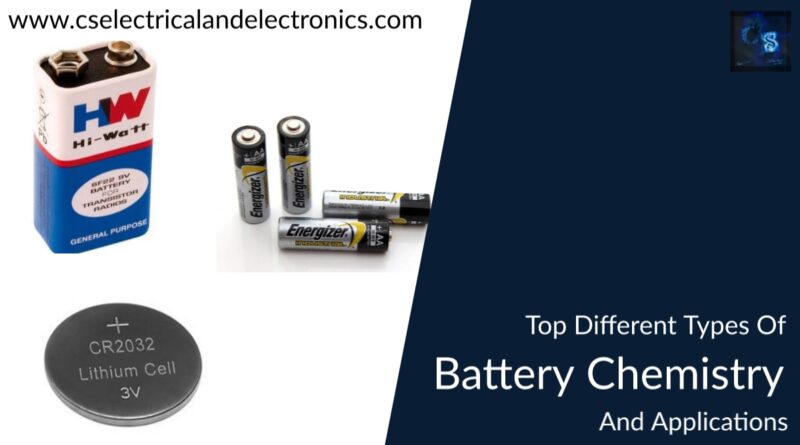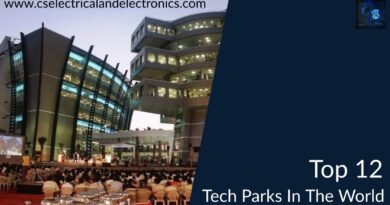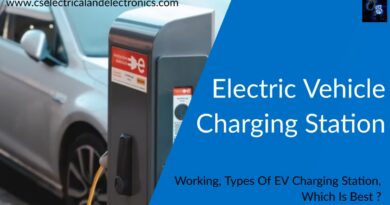Top Different Types Of Battery Chemistry And Applications
Hello guys, welcome back to our blog. Here in this article, we will discuss the top different types of battery chemistry and their applications, and we will also include the benefits and drawbacks of battery chemistries.
If you have any electrical, electronics, or computer science doubts, then ask questions. You can also catch us on Instagram – CS Electrical & Electronics.
Also, read the following:
- What Is SoC In Battery, State Of Charge, Methods, Purpose
- What Is SoE In Battery, State Of Energy, Methods, Purpose
- Difference Between 16-bit, 32-bit, And 64-bit Microcontrollers
Types Of Battery Chemistry
01. Alkaline batteries: We use alkaline batteries in our homes on a daily basis to power flashlights, toys, and other devices. These batteries come in a variety of sizes, including button cells, AA, AAA, C, and D batteries as well as square 9-volt batteries.
02. Zinc-Carbon (Zn): Older than the AA, AAA, C, D, and square 9-volt batteries are zinc-carbon batteries. These batteries are rarely used and have a short lifespan.
03. The majority of silver-oxide batteries are button cells, but several varieties of square 9-volts also use this chemistry. Since the USEPA has classified these batteries as universal waste, most firms are required to ship them to authorized recycling facilities.
04. Lithium-Sulfur Dioxide (LiSO2): Small industrial battery applications typically make use of lithium-sulfur dioxide batteries.
05. The non-rechargeable battery used in AA, C, and D batteries as well as many industrial uses is lithium manganese dioxide (LiMnO2). These can fire when shorted across the terminals since they are very light and have a high energy level.
06. Lithium Thionyl Chloride (LiSOCI2): AA batteries with a higher voltage rate and other industrial uses employ lithium thionyl chloride.
07. Nickel-cadmium (NiCad) batteries are an older rechargeable battery technology that is still in use. They are typically bulkier rechargeable batteries that are utilized in computers and tools.
08. Nickel-Metal Hydride (NiMH) Batteries: Rechargeable nickel-metal hydride batteries are frequently utilized in rechargeable AA batteries.
09. Heavy-duty industrial applications and riding toys for kids both use sealed gelled lead acid batteries.
10. Lead Acid: Lead acid batteries cannot be delivered in recycling kits and are typically used in automobile and motorbike batteries. The majority of the time, car parts shops can recycle these.
11. The most popular rechargeable battery is lithium-ion (Li-Ion), which is lighter and more powerful than previous NiCad batteries. Rechargeable lithium-ion batteries are used in tools, phones, and computers.
12. Phones and other rechargeable devices employ lithium polymer batteries, sometimes known as lithium-ion polymer batteries.
This was about “Types Of Battery Chemistry“. I hope this article may help you all a lot. Thank you for reading.
Also, read:
- 10 Tips To Maintain Battery For Long Life, Battery Maintainance
- 10 Tips To Save Electricity Bills, Save Money By Saving Electricity
- 100 (AI) Artificial Intelligence Applications In The Automotive Industry
- 100 + Electrical Engineering Projects For Students, Engineers
- 1000+ Control System Quiz, Top MCQ On Control System
- 1000+ Electrical Machines Quiz, Top MCQs On Electrical Machines
- 1000+ MATLAB Simulink Projects For MTech, Engineering Students
- 50 Tips To Save Electricity At Home, Shop, Industry, Office
Author Profile
- Chetu
- Interest's ~ Engineering | Entrepreneurship | Politics | History | Travelling | Content Writing | Technology | Cooking
Latest entries
 All PostsApril 29, 2024Top 11 Free Courses On Battery For Engineers With Documents
All PostsApril 29, 2024Top 11 Free Courses On Battery For Engineers With Documents All PostsApril 19, 2024What Is Vector CANoe Tool, Why It Is Used In The Automotive Industry
All PostsApril 19, 2024What Is Vector CANoe Tool, Why It Is Used In The Automotive Industry All PostsApril 13, 2024What Is TCM, Transmission Control Module, Working, Purpose,
All PostsApril 13, 2024What Is TCM, Transmission Control Module, Working, Purpose, All PostsApril 12, 2024Top 100 HiL hardware in loop Interview Questions With Answers For Engineers
All PostsApril 12, 2024Top 100 HiL hardware in loop Interview Questions With Answers For Engineers








